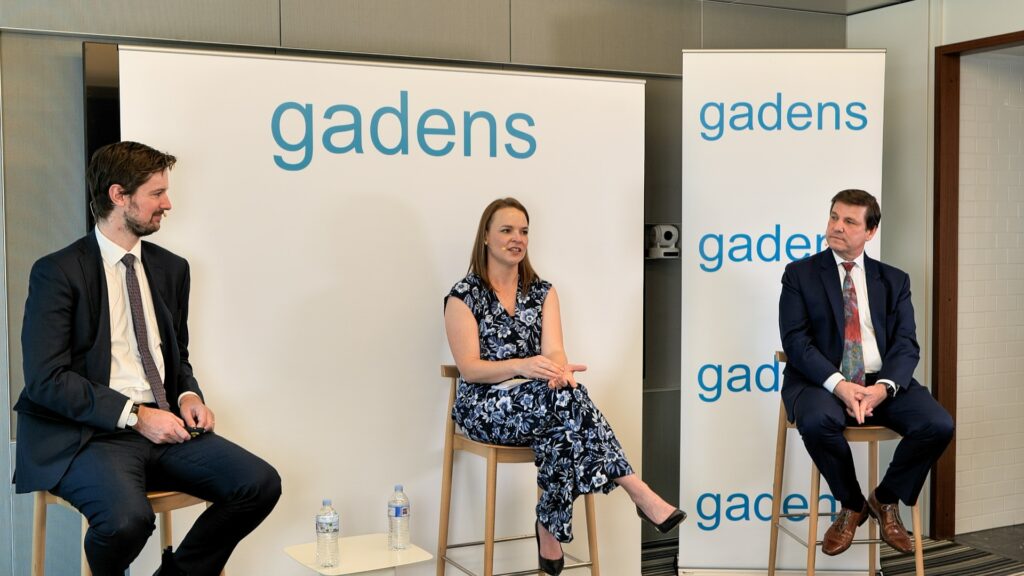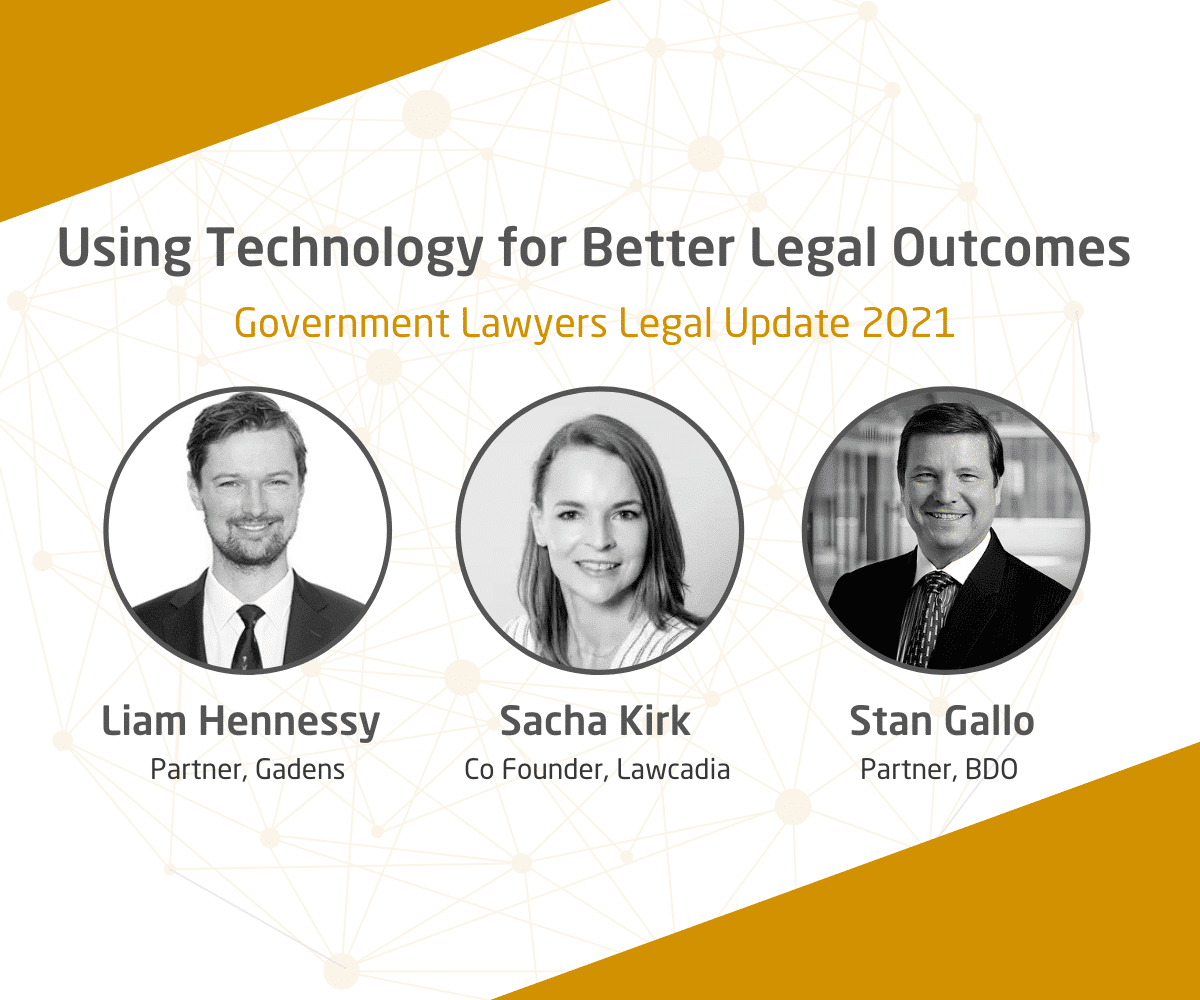At the Gadens Government Lawyers Legal Update 2021, a panel of experts – Liam Hennessy, Partner at Gadens, Stan Gallo, Partner at BDO and Sacha Kirk, Co-Founder and Chief Marketing Officer at Lawcadia – shared their experience using technology to achieve better legal outcomes.
They discussed the use of technology to structure complex workflows, manage data and meet rising regulations, in addition to technology in the age of COVID, and the future of technology for Government Lawyers.
Each panellist made valuable contributions that provided practical insight into how technology is being used to improve legal services. In this article we explore some of these insights, in particular, the innovative solutions that can assist lawyers with complicated workflows, managing large volumes of data and navigating a dense regulatory environment.
Using technology to structure complicated workflows
The concept of a workflow refers to the process of completing tasks from beginning to end according to a predetermined sequence of steps. Traditionally, legal workflows have been a manual process, requiring human input at every step of a task. However today, increasing volumes and complexities of work coupled with time constraints means manual processes are simply inefficient.
According to Liam Hennessy, internal legal departments, including governmental organisations, are increasingly challenged by the amount of work that they need to manage internally and externally in terms of their workflows and ability to track progress, budget, and outcomes.
In response, Sacha Kirk shared how Lawcadia has developed a highly configurable technology platform, Lawcadia Intelligence, that can be used to solve multiple challenges, including the issue of complicated workflows. A key element in creating effective workflows is having alignment between the people, processes, and technology such that the right information can be delivered to the right person in a time-efficient manner. That being so, Lawcadia develops bespoke technology applications to facilitate the individual workflow requirements for a legal department or team, which increases efficiencies, reduces rework, streamlines processes, and captures data for business intelligence reporting.
“At Lawcadia, we look at how you can get the right work, to the right people at the right time. Both internally and externally… We are really big believers that automation and being able to have structure and process around those complex workflows is really the way forward for the industry” said Ms Kirk
A key take away is how technology can assist lawyers to do more with less and add value to the legal function whilst providing data-driven insights that allow better decision making in the future.

Using technology to manage data
“Data volumes are mushrooming, and navigation is a real challenge” – Mr Gallo
According to Stan Gallo, handling large volumes of data requires a specific approach, and to do that process manually is almost insurmountable. With that said, leveraging technology can enable lawyers to search, index, and analyse large volumes of data to find specific information very quickly and very accurately. He spoke of the cloud-based platform RelativityOne and the investigative analytics and intelligence software Nuix, both of which have been developed to assist organisations process all of their data, including emails, social media and communications, for various purposes, including investigations or e-Discovery, in an efficient, secure and cost-effective way.
“Technology assisted review is not necessarily about finding the needle in the haystack, but initially it’s about making the haystack a lot smaller, so you get rid of the irrelevant material to get a focused subset… it removes a lot of the manual labour” said Mr Gallo
Liam Hennessy shared Stan Gallo’s sentiment on the benefits of using technology to manage large volumes of data. He reflected on days as a junior lawyer, during which discovery was a manual process encompassing many weeks, many large boxes of documents and one dark room. That is certainly not the case anymore thanks to data managing technology and the additional capabilities of scaling the technology up or down. This capability means lawyers can manage varying volumes of data, as well as adjust the level of detail at which the data is stored in a given database. The level of detail is known as granularity, and the greater the data granularity, the more useful the data can be for analysis, decision-making or reporting.
Finally, Liam Hennessey provided three key takeaways that demonstrate the importance of using technology to manage data. These are:
-
- Enhanced accuracy in discovery and investigation processes
- Regulators are ahead of the curve and already have access to the technology, therefore, it is likely they will start expecting other organisation’s to be using the technology
- Added value to client service delivery whilst reducing time and financial costs
Using technology to meet rising regulations
The rapid increase in industry-specific regulations has placed great pressure on organisations. To that effect, regulation has become a top concern for Chief Legal Officers in most global regions.
According to Liam Hennessy who specialises in regulatory matters for both private and government clients, technology is imperative in being able to meet the complicated and rising demands of the regulation landscape, in a cost-effective way.
Mr Hennessy described how regulation has become a significant challenge in the private and government sectors:
“Regulation in Australia is mushrooming, much like data… it’s really hard to keep up with the pace of the regulatory change and embed it into the organisation in terms of their risk management frameworks, their policies and procedures and their processes.”
In addition to keeping pace with the changes in the regulatory environment, further challenges, such as potential fines and sanctions, arise due to strict time constraints for regulatory reporting and other regulation-related matters. In an environment where lawyers are having to do more with less, it can be an almost impossible task to meet these requirements time and cost-effectively, whilst ensuring accuracy and service quality. This is where RegTech comes in.
“More RegTech, and more specific types of RegTech is what I’m seeing” – Mr Hennessy
An example of a specific RegTech solution is the Gadens Breach Manager for in-house compliance teams. The platform collates information relating to various regulatory regimes from across organisations, categorises it according to various trigger points, and provides legal teams sufficient functional control to direct it internally or externally, whilst auditing it every step of the workflow. Other specific areas in which RegTech can and is being used to meet the rising regulatory demands include monitoring anti-money laundering, breach reporting, risk management, fraud detection and even to identify misinformation and misleading content on the internet.
“Cybersecurity is an absolute paramount issue at the moment” – Ms Kirk
From Ms Kirk’s perspective a critical aspect in designing RegTech solutions is taking a human-centric, configurable, and secure approach such that the information provided, and actions required are as simplified, logical, and relevant to the client as possible. This ensures the technology can intuitively assist the lawyer without excessive manual input whilst reducing the risk of information overload and most importantly, cybersecurity breaches.
Conclusion
It is clear that technology can and is being used to significantly enhance various areas of functionality within organisations. From navigating complex processes with workflow automation to technology assisted review, to managing regulatory breach reporting, the panellists highlighted the opportunity for organisations to use technology to deliver better legal outcomes. In the next article of this series, we will discuss technology in the age of COVID and how it has evolved to respond to challenges relating to remote work and remote data collection.

